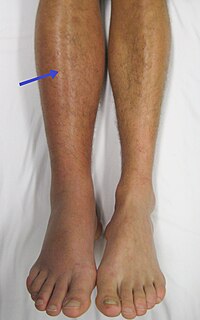
Photo from wikipedia
Background: Direct oral anticoagulants (DOACs) have been used for venous thromboembolism (VTE) in Thailand. However, they have not been listed in the National List of Essential Medicines (NLEM). A cost-effectiveness… Click to show full abstract
Background: Direct oral anticoagulants (DOACs) have been used for venous thromboembolism (VTE) in Thailand. However, they have not been listed in the National List of Essential Medicines (NLEM). A cost-effectiveness analysis is needed to aid policymakers in deciding whether DOACs should be listed in the NLEM. This study aimed to assess the cost-effectiveness of DOACs for patients with VTE in Thailand. Methods: A cohort-based state transition model was constructed from a societal perspective with a lifetime horizon. All available DOACs, including apixaban, rivaroxaban, edoxaban, and dabigatran, were compared with warfarin. A 6-month cycle length was used to capture all costs and health outcomes. The model consisted of nine health states, including VTE on treatment, VTE off treatment, recurrent VTE, clinically relevant non-major bleeding, gastrointestinal bleeding, intracranial bleeding, post-intracranial bleeding, chronic thromboembolic pulmonary hypertension, and death. All inputs were based on a comprehensive literature review. The model outcomes included total cost and quality-adjusted life-years (QALYs) with a 3% annual discount rate. A fully incremental cost-effectiveness analysis and the incremental cost-effectiveness ratio (ICER) per QALY gained were calculated at a willingness-to-pay (WTP) of THB 160,000/QALY ($5003). The robustness of the findings was assessed using deterministic and probabilistic sensitivity analyses. Results: All DOACs were associated with a decreased risk of VTE recurrence and intracranial hemorrhage. In the base-case analysis, apixaban could increase 0.16 QALYs compared with warfarin. An ICER for apixaban was 269,809 Thai baht (THB)/QALY ($8437/QALY). Rivaroxaban had a better QALY than warfarin at 0.09 QALYs with an ICER of 757,363 THB/QALY ($23,682/QALY). Edoxaban and dabigatran could also increase by 0.10 QALYs with an ICER of 709,945 THB ($22,200) and 707,145 THB ($22,122)/QALY, respectively. Our probabilistic sensitivity analyses indicated that warfarin had a 99.8% possibility of being cost-effective, while apixaban had a 0.2% possibility of being cost-effective at the current WTP. Other DOACs had no possibility of being cost-effective. Conclusions: All DOACs were not cost-effective for VTE treatment at the current WTP in Thailand. Apixaban is likely to be the best option among DOACs.
Journal Title: International Journal of Environmental Research and Public Health
Year Published: 2023
Link to full text (if available)
Share on Social Media: Sign Up to like & get
recommendations!